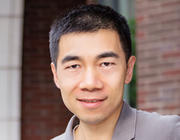M. McCormick, Y. M. Lu, and M. Vetterli, “
Learning sparse systems at sub-Nyquist rates: A frequency-domain approach,” in
Proc. IEEE International Conference on Acoustics, Speech and Signal Processing, Dallas, 2010.
AbstractWe propose a novel algorithm for sparse system identification in the frequency domain. Key to our result is the observation that the Fourier transform of the sparse impulse response is a simple sum of complex exponentials, whose parameters can be efficiently determined from only a narrow frequency band. From this perspective, we present a sub-Nyquist sampling scheme, and show that the original continuous-time system can be learned by considering an equivalent low-rate discrete system. The impulse response of that discrete system can then be adaptively obtained by a novel frequency-domain LMS filter, which exploits the parametric structure of the model. Numerical experiments confirm the effectiveness of the proposed scheme for sparse system identification tasks.
 sparse_lms.pdf
sparse_lms.pdf Y. M. Lu and M. Vetterli, “
Multichannel sampling with unknown gains and offsets: A fast reconstruction algorithm,” in
Proc. Allerton Conference on Communication, Control and Computing. Monticello, IL, 2010.
AbstractWe study a multichannel sampling scheme, where different channels observe scaled and shifted versions of a common bandlimited signal. The channel gains and offsets are unknown a priori, and each channel samples at sub-Nyquist rates. This setup appears in many practical signal processing applications, including time-interleaved ADC with timing skews, unsynchronized distributed sampling in sensor networks, and superresolution imaging. In this paper, we propose a new al- gorithm to efficiently estimate the unknown channel gains and offsets. Key to our algorithm is a novel linearization technique, which converts a system of trigonometric polynomial equations of the unknown parameters to an overparameterized linear system. The computation steps of the proposed algorithm boil down to forming a fixed data matrix from the discrete-time Fourier transforms of the observed channel samples and computing the singular value decomposition of that matrix. Numerical simulations verify the effectiveness, efficiency, and robustness of the proposed algorithm in the presence of noise. In the high SNR regime (40 dB and above), the proposed algorithm significantly outperforms a previous method in the literature in terms of estimation accuracy, at the same time being three orders of magnitudes faster.
 mcsamp_allerton10.pdf
mcsamp_allerton10.pdf A. Hormati, O. Roy, Y. M. Lu, and M. Vetterli, “
Distributed Sampling of Correlated Signals Linked by Sparse Filtering: Theory and Applications,”
IEEE Transactions on Signal Processing, vol. 58, no. 3, pp. 1095-1109, 2010.
AbstractWe study the distributed sampling and centralized reconstruction of two correlated signals, modeled as the input and output of an unknown sparse filtering operation. This is akin to a Slepian-Wolf setup, but in the sampling rather than the lossless compression case. Two different scenarios are considered: In the case of universal reconstruction, we look for a sensing and recovery mechanism that works for all possible signals, whereas in what we call almost sure reconstruction, we allow to have a small set (with measure zero) of unrecoverable signals. We derive achievability bounds on the number of samples needed for both scenarios. Our results show that, only in the almost sure setup can we effectively exploit the signal correlations to achieve effective gains in sampling efficiency. In addition to the above theoretical analysis, we propose an efficient and robust distributed sampling and reconstruction algorithm based on annihilating filters. We evaluate the performance of our method in one synthetic scenario, and two practical applications, including the distributed audio sampling in binaural hearing aids and the efficient estimation of room impulse responses. The numerical results confirm the effectiveness and robustness of the proposed algorithm in both synthetic and practical setups.
 sparse_filtering.pdf
sparse_filtering.pdf Y. M. Lu, M. Karzand, and M. Vetterli, “
Demosaicking by Alternating Projections: Theory and Fast One-Step Implementation,”
IEEE Transactions on Image Processing, vol. 19, no. 8, pp. 2085-2098, 2010.
MATLAB code and imagesAbstractColor image demosaicking is a key process in the digital imaging pipeline. In this paper, we study a well-known and influential demosaicking algorithm based on alternating projections (AP), proposed by Gunturk, Altunbasak and Mersereau in 2002. Since its publication, the AP algorithm has been widely cited and compared against in a series of more recent papers in the demosaicking literature. Despite good performances, a limitation of the AP algorithm is its high computational complexity. We provide three main contributions in this paper. First, we present a rigorous analysis of the convergence property of the AP demosaicking algorithm, showing that it is a contraction mapping, with a unique fixed point. Second, we show that this fixed point is in fact the solution to a constrained quadratic minimization problem, thus establishing the optimality of the AP algorithm. Finally, using the tool of polyphase representation, we show how to obtain the results of the AP algorithm in a single step, implemented as linear filtering in the polyphase domain. Replacing the original iterative procedure by the proposed one-step solution leads to substantial computational savings, by about an order of magnitude in our experiments.
 ap_demosaicking.pdf
ap_demosaicking.pdf 